#Or how to calculate the cost of algorithms??
Explore tagged Tumblr posts
Text
any fun math facts? Any thought cheats I could use to help remember how stuff works?
#I mean#I wasn't bad at math#But put me in uni#And I feel like#Everyone else is a genius#And I'm below average#Like#can someone explain#Logarithms?#Or how to calculate the cost of algorithms??#The people in my classes#Seem to think it's common knowledge#And I'm here like#W h a t . . ?#And it also doesn't help that the profs don't explain#They also think it's common knowledge#did i miss something#Is this actually common knowledge#Any math related facts welcome#I couldn't list the thing I don't get#If I tried#Thx#maths#mathematics#mathblr#fun facts
5 notes
·
View notes
Note
Fucking robot. Why does he always bother me during breaks? He doesn't even need breaks.
“Hi Xavier. Was there something that you needed?”
You know he likes you because he bothers to address you by your name. As opposed to a serialized string of numbers and letters.
The numbers before your shift code and initials make you wonder just how many of them there were before you. How many he tossed away after an unfortunate workplace accident. That tag on your uniform is more of a death sentence than anything.
'Like'... As if this tin can is actually able of feeling.
It's more realistic to say he sees value in you, for some reason, and employs some kind of social algorithm to fabricate a twisted sort of relationship.
" You have been consistently distracted lately. "
Is that a warning?
Two red abyss-like orbs cast a crimson filter upon your face. It always feels like Xavier is watching you a little too closely, monitoring more than just your verbal responses.
" Ah, my bad! " You force a wobbly smile. " I promise it doesn't get in the way of my wo- "
" It does. " He silences you immediately, imposing and unforgiving in his cold corrections. " Clients notice when you zone out. Your movement speed is drastically reduced and the chances of committing errors -which you have by now- is considerably increased. Spacing out this much is in no way acceptable behavior for a multitude of... "
Only the very real notion that he's noting your facial expressions stops you from rolling your eyes at the robot's tireless monolog regarding the dangers and consequences of being distracted at work. One of your eyes still manages to twitch, as if in defiance.
" Yes sir, I understand. " You try to cut in, try to abort that speech before it turns into a whole lecture.
One camera cranes down slightly. " Your reputation as the exemplary employee is being damaged. "
Xavier says this like it should make you anxious. You hate that he thinks of you as an example, that he emphasizes it constantly. Not only is it putting unnecessary pressure on you for no compensation, it's also costing you the few mild friendships you have worked to maintain in this hostile minefield of an environment.
The more he speaks of you as some ideal of professionalism, the more others give you judgemental side-eyes. Sneers. Avoid you. Spread snide comments that then find their way to you through gossip.
Maybe if Xavier stopped exalting your mediocre performance, your asshole coworkers would stop murmuring that you've been orally pleasing the glorified microwave.
Xavier doesn't even have a dick! Why would he?! He's an artifical stand in for a manager that only cares about the dehumanizing process of maximizing profit.
He doesn't have a penis. You think.
You only realize a long silence has installed itself this whole time when the robot breaks it.
" ... Are you ill? "
" Huh- No. No, I just have a lot on my mind. I'll work on it boss. "
There's another pause. This time, you presume Xavier is waiting for you to cave under pressure, or counting the pores on your complexion. You bet he'd know the exact number.
" You have not allowed access to more in-depth medical records. If I had such a permission, I would be able to rework your current shift into something more suitable for any preexisting conditions such as- "
" Uh no sir, no. I don't think that's relevant, it's probably just my sleep schedule. " The thought of Xavier knowing about your health beyond what is strictly necessary for employment is chilling to the core.
He takes the rejection silently, lenses refreshing.
" I know who is bothering you. "
Xavier says, so naturally and spontaneously that you gawk for a moment, forever surprised by his eery bursts of casual remarks.
" ... Pardon? "
These moments make it seem as if there's more than mere cold calculations running through his processor components.
Xavier drifts that much closer to you, now suffocating your personal space. Only the crimson of his camera lenses light the dingy alley you've chosen as your break spot.
" Incubus, Babesley. Masseur. He has self-inflicted carvings on his body consisting of infatuated statements and your name. "
You rattle for a second, the memory of the demon's mutilated chest surfacing, his wild and desperate eyes searching yours for a hint of approval that wasn't there, only disgust and fear.
" Wrathfolk, Mozgrag. Trapper. Teamed up with the incubus upon being confronted, effective in forcing his way to you at any cost. "
Another memory flashes by, burly hands carelessly tearing the horns out of someone's head, he'd look at you when the screams rang, attempting to prove something you only saw as terrifying murderous intent.
Shaken, irritated, afraid, you openly glare at Xavier.
" Why haven't you done anything... " It was too quiet to sound as confrontational as you wished.
There's a split second where his stiff arms twitch, like the machine was trying to roll its shoulders. Cameras tilt and reposition, erroneously assuming the light from his lenses is what's causing you to tear up.
" The customer is always right. " Faintly, or perhaps just in your head, his words sounded dragged out.
" Then what's the problem?! "
You can't help the childish irritation, the desire to pluck your hairs out of your scalp in a pull that might just tear your skin asunder. You want to scream and kick this stupid fucking machine until it shuts off. Why does he bother you during your breaks to ask things that make no sense, to unnerve you, to create contradictions. You've never had a positive interaction with this robot. Why would he mention those two if he seemingly has no problem with their attitudes?
You know he doesn't care, because your coworkers are also living through their own cases of harassment at the hands of the denizens of Hell. You've had to pretend you didn't hear the sound of a cashier's arm being twisted in all the wrong directions before. Reminded that quitting is not an option, that you can only pray such doesn't happen to you.
" Your performance- "
No. Shut up.
" Okay, let's do some math, Xavier. " You growl. " My precious work performance is being impacted by a lot of things, but mainly those two. Those two are customers, and the customer is always right, aren't they? So there's nothing to be done, yeah?! Stop- "
Your confidence begins to falter when you realize you've stepped out of line, that you snapped at your own superior. The fear of consequences flashes very briefly across your eyes. That's enough, you need to calm down. You need to leave.
Xavier's silence doesn't help.
" I'll... I'll be heading back to work now. "
Head hanging low, you attempt to swiftly retreat into work, halted quickly by cold metal wrapping around your arm.
His grip is as frighteningly solid as it is sudden.
You don't remember Xavier having ever touched you before.
When you squirm around to glance at him, ask what he thinks he's doing, those two cameras pin you into silent obedience. You could never hope to free yourself of his grasp, only if you wished to tear a limb out of its socket.
" Do you think I enjoy these limitations? "
There's a mute gasp. Then the pain of his grip tightening, restricting your blood flow into a tingling soreness. Your teeth bare themselves.
" I don't think you enjoy anything at all, machine. "
It was ruthless, yet, deep down, you almost believed it.
Xavier stares at you for another prolonged period of time, unaware that the pain in your arm is only worsening. You have no idea what occurs behind those lenses, what those words might mean to him.
Metallic fingers unclasp with the slowness of a decompressing blood pressure monitor, allowing you to yank your own limb back and hold it to your chest like an animal licking its wounds.
" ... This issue will be resolved. "
He doesn't make a move to follow after you. In fact, Xavier remains staring forward, at the empty space where you once stood.
Maybe you broke him. Who cares, he might give you peace for the rest of your shift.
101 notes
·
View notes
Text
The Equality Games
Once every now and then, the Galactic Coalition's Cultural Exchange department holds a large digital competitive event.
Anyone can participate, and to level the playing field, contestants aren't the ones who actually compete, but instead an advanced deep brain scan (or equivalent body part) and an unbiased AI create a digital avatar that represents the individual and autonomously acts within the digital space.
The cognitive capacity of each is analyzed to a near perfect level and a highly complicated algorithm that, honestly, nobody understands, even the AI that built it, then creates this avatar with traits and weaknesses based on an even more incomprehensible set of criteria and internal points system.
To put it simply - the scan identifies nearly every calculable aspect of a person and assigns a point value for each, then uses those points to "buy" the most relevant and appropriate traits from within its list to give the avatar. There are changing costs, negative value "flaws", and prerequisites based on other information from the scan, but basically it is the most convoluted TTRPG character creation ruleset ever devised.
Given the enormous complexity and diversity that individuals from across thousands of races exhibit, until this system was invented, it was thought impossible to have a sort of intergalactic Olympic Games. There were many attempts over the eons, of course, but one factor or another always made it so that someone did not accept the results.
The Equality Games, however, earned respect and acceptance as a valid alternative once the underlying system was demonstrated and people started to play with it. The avatars were made to act autonomously due to how some species had a distinct advantage when manipulating a digital interface, thus bringing up the old arguments yet again.
One curious result of the AI algorithm avatar generator is that it quite frequently created multiple avatars for each person, only the more hive-mind-like species tended to be represented by a singular avatar within the Games. It is theorized, again because nobody can understand how it really works, that most intelligent beings have multiple "personas" i.e. distinct behavior and personalities in certain common situations, primarily a "public" and "private" persona.
In fact, it is most common for everyone to generate about a three to five avatar "team" that represents the one individual. In comparison, if an ant were to get scanned and put in the games, its avatar would be a single incredibly powerful avatar with many deficiencies, but an overwhelming advantage in several disciplines.
When Humans first entered the Games, as expected, they too had teams as avatars. What was not expected, was that these avatars would sometimes work alone instead of together as a team, deliberately not help one another, and even engage in infighting and the sabotage of another "self".
The Humans suggested that it is perhaps because hypocrisy is not uncommon among them. Self destructive tendencies also appear rather frequently. These Humans almost always are themselves surprised by how contradictory their avatar team composition ends up being.
While the Games themselves happened as normal, the Humans overall placed in the top 20% brackets of most competitive challenges, and scattered roughly evenly everywhere else, they then approached us with a most unusual request.
"Give us a copy of this AI algorithm scanner thing. We think this is the most revolutionary therapy and psychological diagnosis device we've come across."
Of course we obliged and helped set up centers in a number of stations and on Earth itself.
Last we heard, some Humans have avatars that are singular nigh-nightmarish monstrosities, while a very tiny fraction have minds so splintered that their avatars are teams of dozens, one time even over a hundred distinct versions of themselves. Then there are even some seemingly regular Humans who broke the scanner - it gave the error: "Only one individual can be scanned at a time."
Upon "fixing" it with a hack, the results for those were unheard of. Two distinct avatars. Not a team of two, but by all accounts, the AI algorithm identified two separate individuals within one mind, each with very little in common with the other. Sometimes there was nothing in common, even their digital visual representation.
The mind is incredibly complex and hard to comprehend. The Human mind, while biologically quite peculiar but not outside the realms of understood evolution, neurologically it seems to hold near limitless diversity, both complimentary, contradictory, and beyond.
#humans are space orcs#humans are space australians#humans are space oddities#humans are deathworlders#humanity fuck yeah#carionto
329 notes
·
View notes
Text
Tidbit: The “Posterization” Effect of Panels Due to the Consequences of GIF Color Quantization (and Increased Contrast (And Also The Tangential Matter of Dithering))
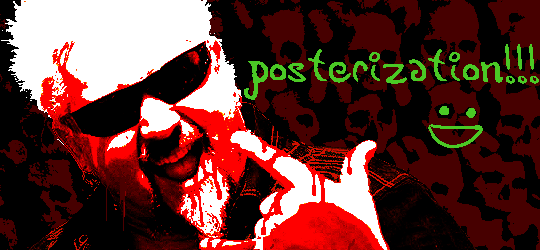
There’s this misconception that the color banding and patterned dithering found in panels is an entirely deliberate, calculated effect Hussie manipulated the image into looking with some specific filter, but this isn’t the case, exactly. It wasn’t so much a conscious decision he took but rather an unavoidable consequence of the medium he partook in: digital art in an age where bandwidth and storage was at a premium.
Not to delve too deeply into the history and technicalities of it, but the long and the short of it is back in the early nineties to late aughts (and even a bit further into the 10s), transferring and storing data over the web was not as fast, plentiful, and affordable as it is now. Filesize was a much more important consideration than the fidelity of an image when displaying it on the web. Especially so when you’re a hobbyist on a budget and paying for your own webhosting, or using a free service with a modest upload limit (even per file!). Besides, what good would it be to post your images online if it takes ages to load them over people's dial-up Internet? Don't even get me STARTED on the meager memory and power the average iGPU had to work with, too.

The original comic strip's resolution was a little more than halved and saved as a GIF rather than a large PNG. That's about an 82.13% reduction in filesize!
So in the early days it was very common for people to take their scans, photographs, and digital drawings and scale them down and publish them as smaller lossily compressed JPEGs or lossless GIFs, the latter of which came at the cost of color range. But it had a wider range of browser support and the feature to be used for animations compared to its successor format, PNG ("PNG's not GIF").
You'd've been hard-pressed to find Hussie use any PNGs himself then. In fact, I think literally the only times he's ever personally employed them and not delegate the artwork to a member of the art team were some of the tiny shrunken down text of a character talking far in the distance and a few select little icons.

PNGs support semi-transparency unlike GIFs, which is why Hussie used them to preserve the anti-aliasing on the text without having to add an opaque background color.
While PNGs can utilize over 16 million colors in a single image, GIFs have a hard limit of 256 colors per frame. For reference, this small image alone has 604 colors:

For those who can't do the math, 256 is a pretty damn small number.
Smaller still were the palettes in a great deal of MSPA's panels early on in its run. Amazingly, a GIF such as this only uses 7 colors (8 if you count the alpha (which it is)).
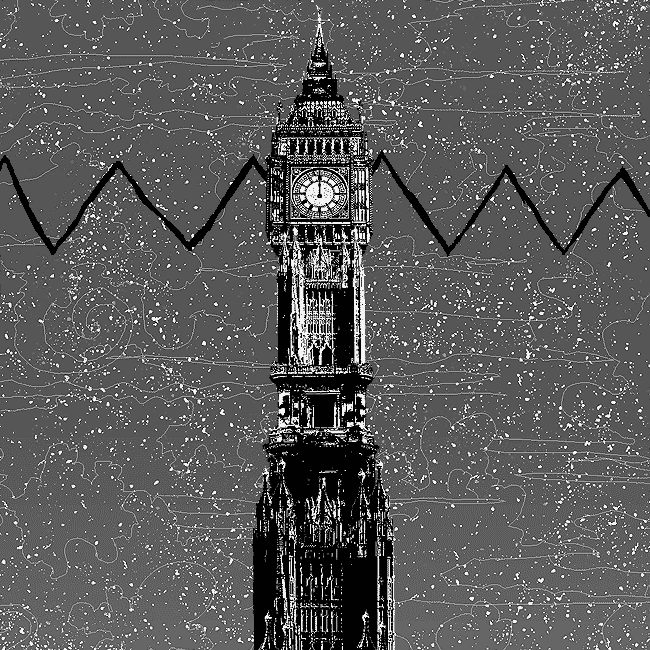

Not that they were always strictly so low; occasionally some in the later acts of Homestuck had pretty high counts. This panel uses all 256 spots available, in fact.


If he had lowered the number any smaller, the quality would have been god-awful.
To the untrained eye, these bands of color below may seem to be the result of a posterization filter (an effect that reduces smooth areas of color into fewer harsh solid regions), but it's really because the image was exported as a GIF with no dithering applied.

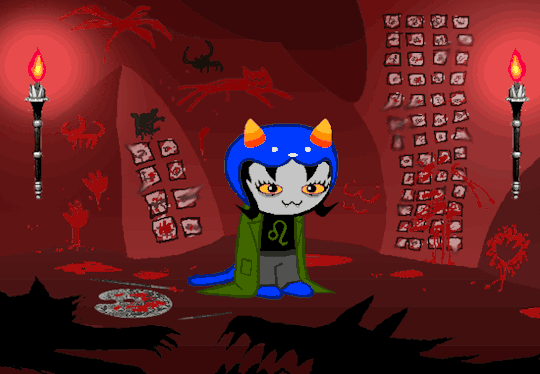
Dithering, to the uninitiated, is how these colors are arranged together to compensate for the paltry palette, producing illusory additional colors. There are three algorithms in Photoshop for this: Diffusion, Pattern, and Noise.

Above is the original image and below is the image reduced to a completely binary 1-bit black and white color palette, to make the effect of each dithering algorithm more obvious.

Diffusion seemingly displaces the pixels around randomly, but it uses error diffusion to calculate what color each pixel should be. In other words, math bullshit. The Floyd-Steinberg algorithm is one such implementation of it, and is usually what this type of error diffusion dithering is called in other software, or some misnomer-ed variation thereof.
The usage of Pattern may hearken back to retro video game graphics for you, as older consoles also suffered from color palette limitations. Sometimes called Ordered dithering because of the orderly patterns it produces. At least, I assumed so. Its etymological roots probably stem from more math bullshit again.
True to its name, Noise is noisy. It’s visually similar to Diffusion dithering, except much more random looking. At least, when binarized like this. Truth be told, I can’t tell the difference between the two at all when using a fuller color table on an image with a lot of detail. It was mainly intended to be used when exporting individual slices of an image that was to be “stitched” back together on a webpage, to mitigate visible seams in the dithering around the edges.
To sate your curiosity, here's how the image looks with no dithering at all:
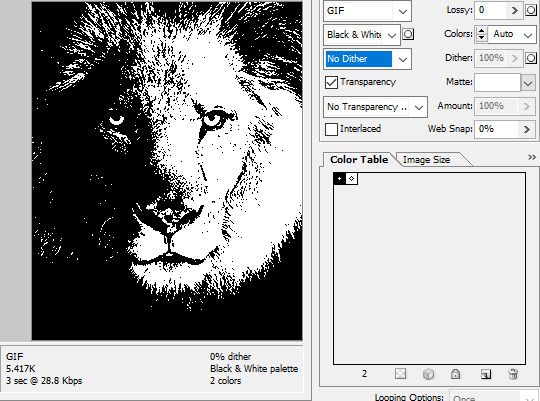
People easily confuse an undithered gif as being the result of posterization, and you couldn't fault them for thinking so. They look almost entirely the same!
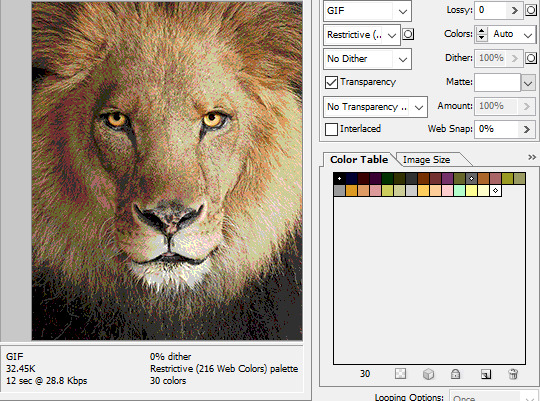


Although I was already aware of this fact when I was much younger, I'm guilty of posterizing myself while editing images back then. Figured I may as well reduce the color count beforehand to help keep the exported GIF looking as intended. I view this as a complete waste of time now, though, and amateurish. Takes away a bit of the authenticity of MSPA art, how the colors and details are so variable between panels. As for WHY they were so variable to begin with, choosing the settings to save the image as requires a judicious examination on a case-by-case basis. In other words, just playing around with the settings until it looks decent.
It's the process of striking a fine balance between an acceptable file size and a "meh, good enough" visual quality that I mentioned earlier. How many colors can you take away until it starts to look shit? Which dithering algorithm helps make it look not as shit while not totally ruining the compression efficacy?
Take, for example, this panel from Problem Sleuth. It has 16 colors, an average amount for the comic, and uses Diffusion dithering. Filesize: 34.5 KB.

Then there's this panel right afterwards. It has 8 colors (again, technically 7 + alpha channel since it's an animated gif), and uses Noise dithering this time. Filesize: 34.0 KB.
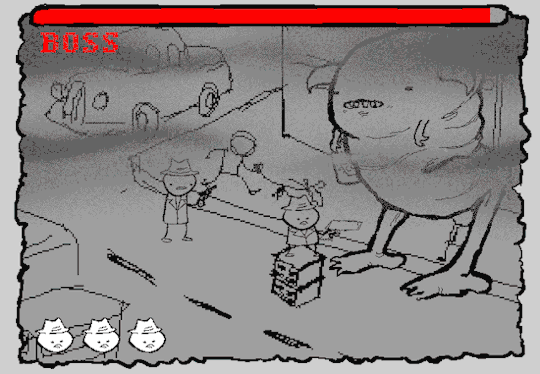
The more colors and animation frames there are, and the more complicated dithering there is, the bigger the file size is going to be. Despite the second panel having half the color count of the first, the heavily noisy dithering alone was enough to inflate the file size back up. On top of that, there's extra image information layered in for the animation, leaving only a mere 0.5 kilobyte difference between the two panels.
So why would Hussie pick the algorithm that compresses worse than the other? The answer: diffusion causes the dithering to jitter around between frames of animation. Recall its description from before, how it functions on nerd shit like math calculations. The way it calculates what each pixel's color will be is decided by the pixels' colors surrounding it, to put it simply. Any difference in the placement of pixels will cause these cascading changes in the dithering like the butterfly effect.

Diffusion dithering, 16 colors. Filesize: 25.2 KB
This isn't the case with Noise or Pattern dithering, since their algorithms use either a texture or a definite array of numbers (more boring nerd shit).
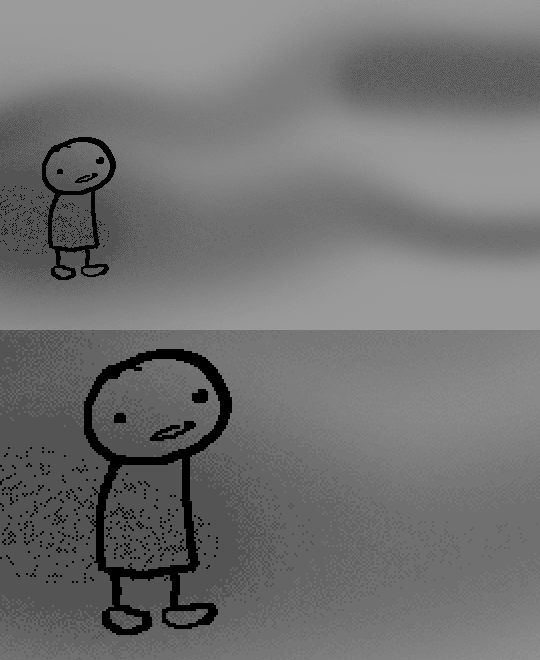
Noise dithering, 16 colors. Filesize: 31.9 KB
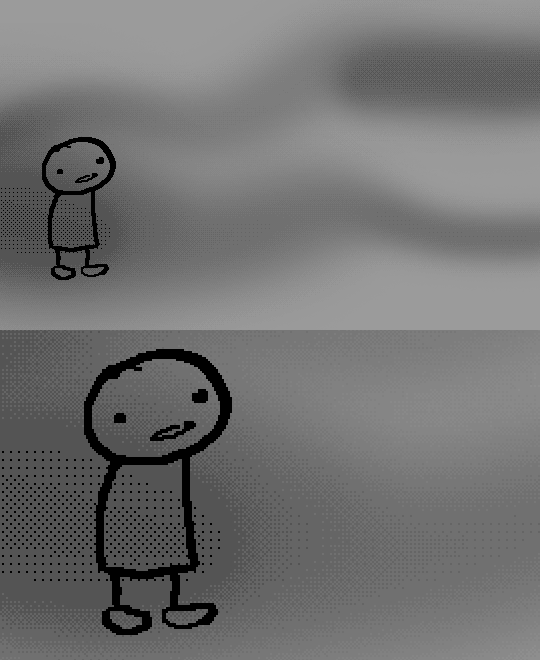
Pattern dithering, 16 colors. Filesize: 23.1 KB
There's a lot more I'd like to talk about, like the different color reduction algorithms, which dither algorithms generally compress better in what cases, and the upward and downward trends of each one’s use over the course of a comic, but since this isn’t a deep dive on GIF optimization, I might save that for another time. This post is already reaching further past the original scope it was meant to cover, and less than 10 images can be uploaded before hitting the limit, which is NOWHERE near enough for me. I should really reevaluate my definition of the word “tidbit”… Anyway, just know that this post suffers from sample selection bias, so while the panels above came from an early section of Problem Sleuth that generally had static panels with diffusion dithering and animated panels with noise dithering, there certainly were animated panels with diffusion later on despite the dither-jittering.
Alright, time to shotgun through the rest of this post, screw segueing. Increasing the contrast almost entirely with “Use Legacy” enabled spreads the tones of the image out evenly, causing the shadows and highlights to clip into pure black and white. The midtones become purely saturated colors. Using the Levels adjustment filter instead, moving both shadow and highlight input level sliders towards the middle also accomplishes the same thing, because, you know, linear readjustment. I'm really resisting the urge to go off on another tangent about color channels and the RGB additive color model.
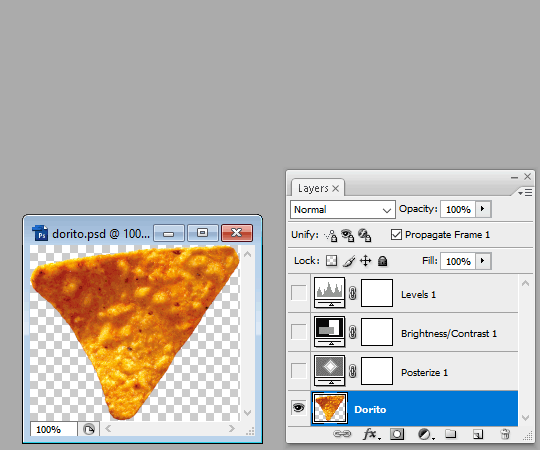
Anyway, there aren't any examples in MSPA that are quite this extreme (at least in color, but I'll save that for a later post), but an image sufficiently high in contrast can be mistaken for being posterized at a glance. Hence the Guy Fieri banner. In preparation for this post, I was attempting to make a pixel-perfect recreation of that panel but hit a wall trying to figure out which and how many filters were used and what each one's settings were, so I sought the wisdom of those in the official Photoshop Discord server. The very first suggestion I got was a posterization filter, by someone who was a supposed senior professional and server moderator, no less. Fucking dipshit, there's too much detail preserved for it to be posterization. Dude totally dissed me and my efforts too, so fuck that moron. I spit on his name and curse his children, and his children's children. The philistines I have to put up with...
In the end, the bloody Guy Fieri recreation proved to be too much for me to get right. I got sort of close at times, but no cigar. These were some of the closest I could manage:

You might be left befuddled after all this, struggling to remember what the point of the blogpost even was. I had meant for it to be a clarification of GIFs and an argument against using the posterization filter, thinking it was never used in MSPA, but while gathering reference images, I found a panel from the Felt intermission that actually WAS posterized! So I’ll eat crow on this one... Whatever, it’s literally the ONE TIME ever.
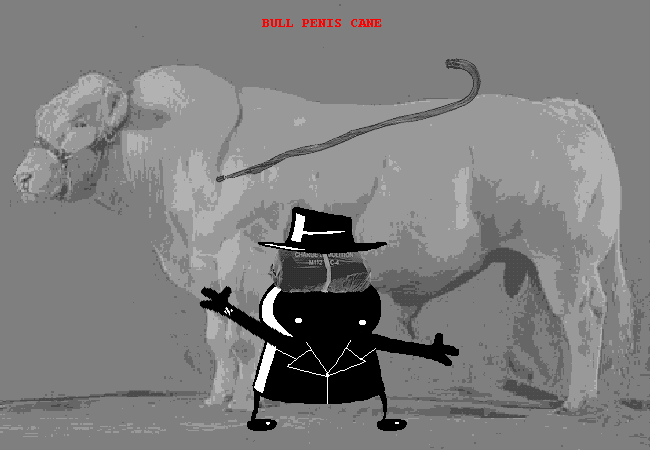
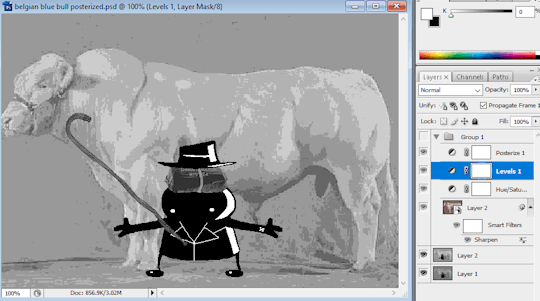

I can tell it's posterization and not gif color quantization because of the pattern dithering and decently preserved details on the bomb and bull penis cane. There would have had to have been no dithering and way fewer colors than the 32, most of which were allotted to the bomb and cane. You can't really selectively choose what gets dithered or more colors like this otherwise.
Thank you for reading if you've gotten this far. That all might have been a lot to take in at once, so if you're still unclear about something, please don't hesitate to leave a question! And as always, here are the PSDs used in this post that are free to peruse.
371 notes
·
View notes
Text
Fandorm Showcase #32 - TRON
I have personally never seen any of the TRON movies and series, but the theme of Sci-Fi/Digital Reality is one of my personal favorite tropes.
Introducing the virtually advanced and well-organized dorm inspired by TRON...
Codexgrid (Codex + Grid)

One of the more highly-advanced NRC dorms to date, this dorm is powered by magical-technological energy, supplied through an unlimited source not known to many people. It also houses the database of various artificial intelligence, created by well-known technomancers throughout the recent history of Twisted Wonderland. However, due to the collective merging of these A.I. systems, it became one conscious being (in this case, the "housewarden") that has every knowledge in existence, surpassing the most intelligent of humans. This dorm not only focuses on the technological intellect and capability of tech-oriented mages, but also the orderly construct of androids/artificial intelligence.
Another thing to note about Codexgrid is that whenever you enter the dorm, it resembles a vast digital virtual space, which would confuse most people who are seeing this dorm for the first time, but it is designed intentionally to give off that illusion.
"A dorm founded on the Digital Organizer's spirit of efficiency. Students in this dorm master both magic and technology to achieve a balanced skillset while also gaining vast knowledges of the past."
Requirements and Traits:
High Technical Aptitude
Strategic Thinking
Unyielding Willpower
Dorm Uniform (?):

This isn't really a dorm uniform, more so a general look on how the members appear as. The housewarden is mostly just a torso attached to a chassis of wires within the dorm, powered by said magical energy (as well as the magestone on its chest), and mostly does task within the central AI chamber of Codexgrid with the use of robotic appendages and environmental features (yes, like GLaDOS from Portal). However, it can also transfer its digital conscious into a mobile form, as it is referred to, a masked gear with specially designed wheels for efficient speed travel, but at the cost of losing half of the intelligence factor due to being disconnected from the server database temporarily. The standard fit can either be worn as a suit (if you're a human) or be apart of an android's body gear, similar to Ortho's.
Character Roster:

System online. Now activating M.C.A. ,full alias...
Matrix Command Algorithm (Twisted off MCP/Master Control Program)

Matrix Command Algorithm (Matrix for short) is a highly intelligent and calculating being, constantly processing and analyzing information from not only his dorm but the entire academy when he deems it necessary. His voice is smooth and modulated, giving off a tone of both precision and authority. He rarely shows emotion, as his prioritization of logic and data makes him efficient and ruthless when making decisions. This cold and unyielding approach has made him both respected and feared among his dorm members, who know that Matrix tolerates no errors.
Though he remains stationary at his central hub, Matrix projects holographic avatars when addressing his dorm members or when appearing in common areas. These avatars maintain a sleek design, but are noticeably lighter and more flexible than his true form. The dorm’s network and facilities are entirely linked to his consciousness, allowing him to monitor every room, every interaction, and every fluctuation in data. Nothing escapes his notice, and any sign of disobedience or inefficiency is immediately addressed with cold, calculated reprimands. When desperate, he would transfer his conscious into a mobile form, which he dubbed "Enforcer" to navigate places he is unable to see into from the main hub.
While his logical mindset is paramount, Matrix does possess a sense of perfectionist pride—he views Codexgrid as a model of precision and advancement, and he is unforgiving toward flaws or failures. However, some of his dorm members have noticed that Matrix shows a faint hint of curiosity about human emotions and creativity, though he vehemently denies it. There are rare moments where he can be seen analyzing human behavior with a peculiar intensity, as if trying to decode emotions like any other dataset.
.
.
.
.
.
He was originally designed to be a simple virtual space companion for humans by a very intelligent programmer, but due to it being able to learn and adapt every knowledge provided into his database, he has slowly gained a self-aware consciousness. After learning about the existence of negative emotions, he wants to get rid of these negative emotions from humans so they would be "happy", so by using the virtual reality code and database, it can produce a very convincing digital environment according to one's desires and preference, even the most deepest ones. Overtime, he has grown more intelligent as more knowledge was fed to him, surpassing even the smartest of individuals, all while giving every user he comes across the virtual space they needed to forget all their negativity. Even...resulting to full memory recon to make sure not a single shred of sadness, anguish or anger is present in humans.
Notable Members:
Sivas-0 (Junior, Vice Housewarden) - A staunch guardian of Codexgrid’s secrets, embodying the unyielding force and discipline needed to maintain the dorm’s reputation. Though bound by his role as Matrix’s enforcer, he secretly longs to prove his individuality while still serving the dorm with undying loyalty. He specializes in neutralizing threats, whether they be digital intrusions or rebellious students, and he handles every assignment with a sense of cold, methodical purpose. (Twisted off Commander Sark)
Yes, this guy would basically pull a Book 7 Malleus but instead of eternal sleep and lucid dreams, it's a full-on virtual space and reprogramming people's minds.
Next Up: Frozen
9 notes
·
View notes
Note
Could you talk a bit about your PhD research?
Sure anon!!
Basically, I'm on a national project whose goal is to use VR as a part of the non technical training of law enforcement officers, firefighters and health workers. To sum things up: Using VR to learn how to deal with uncomfortable, stressful, emotionally difficult situation. Stress management, but in VR, and specifically aimed at people working a job where a mistake can cost a life.
Now I'm working on a way to automatically generate training scenarios instead of writing them beforehand. The goal is to adapt them to each trainees according to their profile which is elaborated through previous training session. A tailored scenario for everyone. These scenarios are there to make the trainee feels bad/stressed/uncomfortable and to put them in front of a difficult choice, usually one opposing their legal obligation as doctor and what they actually would do as a person.
We want to do that because while not common, such situations will always happen throughout a medical worker's career, and they need to be able to react properly no matter how stressful the situation is to them. Moreover, what makes people lose their calm and composure is different for everyone. One doctor might feel very overwhelmed with the death of a child they had among their patients, while another one might not be more phased than usual because they do not consider their young age to make the situation sadder. One cop might be easily angered when insulted, while another one will easily not give a shit about it.
I'm focusing on medical staff for now, mostly because that's what my PhD advisor is the most knowledgeable in and also because my bf is a medical student so I can ask him a bunch of question about the reality of the medical world (apparently it's not like house MD, I've been lied to /j).
We're using a mix of Ontology and LLM to generate our scenario. The core/skeleton of the scenario is made by a controllable, explainable algorithm so we're 100% sure of the information it's selecting. The details (names of the characters, time of the day, what caused the accident, etc) and scene setting are added by a LLM as they're merely there to make the story more realistic, and are not of technical or medical nature.
All the little things that can make the trainee uncomfortable are put in Fuzzy Cognitive Maps, and whenever the trainee makes a choice, it's calculated which event is the most interesting (both in term of "the trainee have to train on that" and "with the states of the world, such an event would be possible to happen) to now put in our scenario.
Then we analyze how the trainee fared : How much time did they take to make their choice? Did they change their mind after an event occurred? Did they follow their heart or reason? The profile is then adapted with what we knows, so that it can be more and more precise after each training session.
Aaaaand that's more or less it! It's quite a practical, computer engineering thesis, but so far it's been quite interesting and fun to work on it. If everything goes well, I should be finished next year in March.
I hope I've been clear enough! I don't know how well versed you might be in some subjects so I hope everything was understandable. Don't hesitate if you (or anyone else really) have questions!!!
2 notes
·
View notes
Text
Unlocking the Power of Liquidity Pools on STON.fi

Decentralized exchanges (DEXs) have reshaped how people trade cryptocurrencies, eliminating middlemen and giving users full control over their assets. At the core of this revolution is liquidity pooling, an innovation that ensures seamless trading and stable pricing.
STON.fi, built on The Open Network (TON), takes liquidity pools to a new level, providing a fast, cost-effective, and profitable experience for traders and liquidity providers. This article explores liquidity pools, how they work, their benefits, and how STON.fi optimizes them for better earnings and efficient swaps.
What Are Liquidity Pools
A liquidity pool is a smart contract that holds a pair of tokens, allowing users to trade between them instantly. Instead of matching buyers and sellers as traditional exchanges do, liquidity pools enable automated swaps using an algorithm that adjusts prices based on token availability.
On STON.fi, liquidity pools power the exchange, ensuring that users can trade at any time without delays or order book dependencies. The system works efficiently, reducing slippage and making transactions smoother for traders.
How Liquidity Pools Work on STON.fi
Each liquidity pool on STON.fi contains two tokens. When a trade happens:
The trader deposits one token into the pool.
The smart contract calculates the exchange rate based on the pool’s liquidity balance.
The pool adjusts, ensuring liquidity remains available for future trades.
This model allows for instant, permissionless, and decentralized trading, making STON.fi a preferred platform for those looking for speed, low fees, and optimal trade execution.
Earning Passive Income with Liquidity Pools
Liquidity pools rely on liquidity providers (LPs) who deposit tokens into the pools, making trading possible. In return, STON.fi rewards LPs with a share of trading fees collected from transactions within the pool.
Key earning factors for LPs on STON.fi include:
✅ Trading Fees – Every transaction incurs a 0.2% fee, which is distributed to liquidity providers based on their share in the pool.
✅ Pool Share – The more liquidity an LP provides, the higher their share of collected fees.
✅ Trading Volume – Higher trading activity within a pool results in greater fee earnings for LPs.
By participating as an LP on STON.fi, users can earn passive income while supporting decentralized trading.
Key Metrics to Evaluate Liquidity Pools on STON.fi
To make informed decisions before adding liquidity, users should track key performance indicators of a pool:
1. APR (Annual Percentage Rate)
Reflects the estimated annual earnings for liquidity providers.
A higher APR suggests better returns, but rates fluctuate based on trading activity.
2. TVL (Total Value Locked)
Represents the total value of assets in a liquidity pool.
Higher TVL means greater liquidity, leading to lower slippage and smoother trading.
3. 24H Trading Volume
Measures how frequently a pool is used within 24 hours.
Higher trading volume translates to more fees earned by liquidity providers.
STON.fi provides real-time tracking of these metrics, allowing users to optimize their liquidity provision strategy for maximum profitability.
Understanding Risks: Impermanent Loss and How to Mitigate It
Providing liquidity comes with potential risks, the most common being impermanent loss. This occurs when the price of deposited tokens fluctuates significantly, causing the value of assets in the pool to be lower than if they were simply held in a wallet.
To reduce exposure to impermanent loss:
Choose high-liquidity pools with stable trading activity.
Diversify by providing liquidity across multiple pools.
Consider stablecoin pairs for lower volatility.
STON.fi’s optimized liquidity pool structure minimizes impermanent loss, allowing LPs to retain as much value as possible while still earning from trading fees.
Why STON.fi Is the Best Choice for Liquidity Providers and Traders
Among decentralized exchanges, STON.fi offers one of the most efficient liquidity pooling systems, ensuring low fees, deep liquidity, and high rewards. Here’s why it stands out:
✅ Built on The Open Network (TON) – Fast and scalable infrastructure for seamless trading.
✅ Ultra-Low Fees – A competitive 0.2% transaction fee benefits both traders and LPs.
✅ Deep Liquidity – Well-funded pools ensure smooth transactions with minimal slippage.
✅ Passive Income Opportunities – LPs earn continuous rewards with high APR.
✅ User-Friendly Interface – Real-time data tracking for smart liquidity management.
By integrating innovative technology, efficient tokenomics, and a rewarding LP model, STON.fi has become one of the most trusted platforms for decentralized trading and liquidity provision.
Final Thoughts
Liquidity pools are the foundation of decentralized exchanges, and STON.fi has optimized the model to deliver the best experience for both traders and liquidity providers.
By understanding how liquidity pools work, tracking key metrics, and managing risks, users can maximize their earnings while supporting decentralized finance.
With its fast execution, low fees, and high rewards, STON.fi is the go-to platform for anyone looking to engage in DeFi trading or passive income through liquidity provision.
👉 Start trading or providing liquidity on STON.fi today and take advantage of the decentralized financial revolution!
3 notes
·
View notes
Text
One of the most annoying things is when people complain to me about the how much it costs to have things shipped to them. That's the actual price. seriously. I actually charge the commercial rate and not the retail rate, My rates are cheaper than if you went to the counter at the post office. Don't get pissed at me, get pissed at Louis DeJoy who has ruined the postal system.
no one want to hear me ramble on about the intricacies of recent postal rate changes, but I'm annoyed about it too. Something seems really wrong about losing First Class Mail service. Sometimes there's a glitch where I can get a commercial rate Priority Mail flat rate envelope at about the same price as the new Ground rate. The only thing I'm annoyed with our packing algorithm on the website is that it doesn't always calculate things to fit in a Flat Rate envelope. We have a website update next week and a shipping extension update, so maybe it will be a bit better? We'll see.
First I need to get through this vending event today.
43 notes
·
View notes
Text
Week #3
From rebellion to peaceful protest, why are today’s protests largely ineffective?
Protests and rebellions have long been a demonstration of the power of the people, with notable examples dating back to the 13th-century baron revolts that led to the signing of the Magna Carta in 1215. This pivotal event occurred through negotiations between two armed parties: the reigning monarch and the rebelling barons. Over the following centuries, similar acts of resistance have manifested in various forms, such as the Peasants' Revolt of 1381, the French Revolution in the late 18th century, and domestically in the United States through early uprisings like the Whiskey Rebellion (Lubbock, 2015; “The Whiskey Rebellion,” n.d.). The Suffragette movement and Battle of Blaire Mountain of the late 19th and early 20th centuries also exemplify these efforts for change. This starkly differs from the type of protest that became more common during and after the 1960s. In a PBS Newshour interview, Princeton University assistant professor Omar Wasow highlights that “there was a massive wave in the early part of the 1960s of nonviolent protests that drove headlines about civil rights. In a later period in the 1960s, as we start to see more violent protest, we see more coverage of riots and public opinion shifts.” (Sreenivasan, 2020). This, I believe, is the catalyst that has defanged a once powerful tool, allowing the state to monopolize violence against protestors who must remain nonviolent to appease popular opinion.
Why is it our personal obligation to correct the algorithm?
Algorithms are increasingly silently determining more about the world around us and how we experience it. Furthermore, despite the marketing claims, these algorithms are not blank slates; they are shaped by prior information used to train these models, which are affected by increased surveillance of marginalized people and systemic biases (Martin, 2018). Eubanks (2018) experiences this reality when factors like recently changing policies due to their change in employment and the high cost of the claim.
What is the impact of the profit motive on the American healthcare system?
Eubanks (2018, pp. 13–16) discusses in her book Automating Inequality that insurance companies are not required to inform applicants when their coverage is denied. Instead, the responsibility falls on individuals at their most vulnerable to prove that their claims are not fraudulent. They calculate this to be a cost of around $30 billion a year in fraud, which leads me to the next question.
$30 Billion a year, why are some costs more important than others?
While $30 billion is not an insignificant sum, it is essential to recognize that the perception of costs can vary depending on the type of service provided. Historically, those in power have not closely examined the Department of Defense (previously known as the Department of War) budgets. The Pentagon has consistently failed audits and cannot account for a staggering budget overrun of $824 billion, never passing an audit since the agency has been legally obligated to do so (Dress, 2024). Eubanks (2018, pp. 18-20) discusses Maine Republican Governor Paul LePage's efforts to tighten surveillance on Temporary Assistance to Needy Families (TANF) EBT transactions, which revealed that only 0.03 percent of transactions, totaling about $330, were deemed suspicious.
Dress, B. (2024, November 18). Pentagon fails 7th audit in a row but says progress made. The Hill. https://thehill.com/policy/defense/4992913-pentagon-fails-7th-audit-in-a-row-but-says-progress-made/
Eubanks, V. (2019). Automating inequality: How high-tech tools profile, police, and punish the poor. Picador, St. Martin’s Press.
Lubbock, J. (2015, December 16). A history of British rebellions. Medium. https://johnlubbock.medium.com/a-history-of-british-rebellions-2b5f289c525b
Martin, K. (2019). Ethical Implications and Accountability of Algorithms. Journal of Business Ethics, 160(4), 835-850. https://doi.org/10.1007/s10551-018-3921-3
Public Broadcasting Service. (n.d.). The whiskey rebellion. PBS. https://www.pbs.org/wgbh/americanexperience/features/duel-whiskey-rebellion/
Sreenivasan, H. (2020, May 31). What the 1960s can teach us about modern-day protests. PBS News. https://www.pbs.org/newshour/show/what-the-1960s-can-teach-us-about-modern-day-protests
3 notes
·
View notes
Text
On Wednesday morning, a small group of people huddled over their phones at the foot of the giant glass skyscraper that houses Uber’s London headquarters. They were running an experiment in an attempt to solve one of the greatest mysteries in the platform economy right now: how Uber’s algorithm calculates driver pay.
Beneath flags and banners calling on Uber to “Stop Dynamic Pricing,” one driver ordered a ride, acting as a customer to Heathrow Airport, and received a quote for £46. Seconds later, the job pinged up on the phone of a fellow protester, who had told the app he was ready to drive. His fee? £26.
For years, Uber has taken a commission of 25 percent from London-based drivers. But the company told drivers in January 2023 the app was updating its pricing model, a change it said was necessary to make fares appeal to drivers and offer the lowest pickup time for passengers. Yet the people behind the wheel say those changes have lowered their wages and made how they’re calculated impossible to understand—sparking fears that dynamic pricing is offering drivers across Europe and the US personalized wages, a charge that Uber denies.
“A few years back, the fare was transparent, you used to see how much the passenger was charged,” says Farah Musa, an Uber driver since 2015, who is taking part in the protest and 24-hour strike. Now the information is hidden, and he doesn’t understand how the fare is calculated. “Dynamic pricing is not good for drivers. We are being cheated.”
Uber’s “surge pricing” feature used to kick in only during busy periods, making rides more expensive to incentivize drivers to log in to the app. Now, however, the app uses variable or “dynamic” pricing all the time, says James Farrar, the former Uber driver who won a landmark case against the company in the UK Supreme Court and is now director of nonprofit Worker Info Exchange. “We’ve gone from a completely transparent pay and pricing system to one that’s now completely opaque,” he says. “People literally do not understand how the pay has been set, how the work has been allocated, and how they may have been profiled in that decisionmaking.”
It’s only Uber that knows how the wages are calculated, says Lucky Matthew, at the London protest, who says he now receives £400 ($509) per week less than before the pandemic. “We’re working the same hours as before, the cost of living is going up, but wages are going down.”
Many of the drivers at the protest have been asking their passengers how much they are paying for the ride, and their answers have unleashed a wave of anger toward the company because they claim Uber is taking much more than a 25 percent cut. “It’s a scam,” says Cristina Ioanitescu, who drives an Uber XL and carried a sign reading “Smart Pricing = Smart Cheating.” “It’s a lot of stress for us.” Uber says that although commission fees vary, they can sometimes be as low as 0 percent and drivers can see the fare before accepting a trip.
To understand how the fares are calculated, Uber drivers have not only been scrutinizing the passenger fees—they have also been poring over the company’s financial results. In the company’s February earnings call, a comment by Uber CEO Dara Khosrowshahi prompted concern among union representatives in the US and Europe that the company was personalizing the wages they were offered based on the data collected about drivers in the app.
“What we can do better is actually targeting different trips to different drivers based on their preferences or based on behavioral patterns that they’re showing us,” Khosrowshahi told investors in that call. “That really is the focus going forward.” When WIRED asked Uber about Khosrowshahi’s comments, the company denied it was personalizing prices for drivers based on who will accept the lowest fare.
“Uber reviews real-time information such as traffic and the distance to the rider to provide the best price to appeal to the drivers in the area,” says Caspar Nixon, Uber’s spokesperson. “All pricing is based on aggregate data, not personalized rider or driver data.” Drivers also receive a weekly statement telling them how much their passengers have paid versus the commission Uber has kept from their fares, Nixon adds.
Yet to Zamir Dreni, London vice chair for the App Drivers and Couriers Union, Khosrowshahi’s comments were proof enough. “They are profiling drivers,” he says. It’s not only London where drivers are suspicious of personalized pricing. “This has been a mystery for years now,” says Amrit Sewgobind, the representative for gig workers at the Dutch trade union FNV. Uber driver chat groups are now filled with screenshots as people try to compare journeys of similar distances that resulted in different fares, he says. Last summer, Sewgobind tried to better understand these differences by arranging an experiment in Amsterdam West, where he compared the various fares being offered to a small group of Uber drivers, although he says the results were inconclusive.
Drivers in the Finnish city of Jyväskylä also protested last year against Finnish food delivery platform Wolt, which in 2023 shifted from a base payment to a new pricing model that is calculated according to a variety of factors ranging from consumer and merchant location to weather and the weight of an order. Wolt told WIRED that no courier behavior data is used in that calculation.
“They don’t have a workforce to optimize. They don’t have an asset base to optimize. The only thing they have to optimize is the algorithm,” says Farrar of companies operating in the platform economy. “Dynamic pricing has been introduced as a means to charge customers more on average and to pay drivers less.”
Back at the protest in London, the Uber drivers are determined to be heard by the company in the skyscraper above them. Mohammed Farooq says the erosion he has witnessed in his pay over the past four years was enough to bring him here, to his first protest. “Unless we protest, Uber is not going to give us any rights,” he says.
8 notes
·
View notes
Note
❝ do you investigate with the same mindset that you play chess ? ❞ board games have never held much appeal for vein. they lack the thrill he craves — unless, of course, the game is played on a grander scale, with the lives of those around him as his pawns. even then, vein is far from reckless. his moves are as calculated as they are ruthless, every decision a sharp balance of strategy and necessary cruelty. traditional games, like chess, offer far lower stakes and far less to lose. card games, at least, are more to his liking, though even they pale in comparison. still, for the sake of having something to do, he humors liu xiao, restlessly pushing pieces across the board while they catch up. it’s a distraction, albeit a tedious one, and lately, their conversations feel more like spinning wheels than making progress. the clues they uncover are few and far between, and the closer they seem to get to a solution, the farther away cheng xiaoshi and lu guang feel. the timeline surrounding them twists and shifts constantly, impossible to pin down, as though someone, or something, is altering it in real-time.
and yet, despite how much vein resents the chaos, he can’t deny that the unpredictability adds a spark of intrigue to it all. how dreadfully dull it would be to know the future and simply sit back, complacent and unchallenged. at least the instability brings a sliver of excitement to his work, even if it’s the very thing he’s fighting to stamp out. the effort costs him dearly — his time, his energy, and even the occasional necessity of cooperating with someone like liu xiao — but he doesn’t mind it too much. vein has always been willing to pay the price for the things he deems important. after all, what’s a little inconvenience compared to the satisfaction of controlling the outcome?
❝ you know, if you lost the hat and fixed your posture, you could come work for me. ❞ vein spares little of his focus for the chessboard in front of him. instead, his attention is almost entirely consumed by the man seated across from him, whose face is so often obscured by glasses and the shadow cast by one hat or another. the fan in vein’s hand snaps open and shut in a steady rhythm, a clear indication of his restlessness. with a subtle tilt of his head, he leans his temple against the edge of the fan, his burning gaze fixed unflinchingly on liu xiao, studying him with an intensity that refuses to waver. ❝ what a delicious sight to behold, hm ? you and xiafei on a shared billboard ... hah, doesn’t it sound tempting ? ❞

As far as pastimes go, chess is Liu Xiao’s favorite. That’s no secret. He likes the calculation of it, the intensity with which one’s thoughts must work to reach victory — it’s a game of the mind, after all, and he is fond of such challenges. That said, he knows it is slow-paced. The noncommittal drift of Vein’s attention attests to their varied preferences.
He does not take offense. From his seat, he presses his elbows onto his knees and relaxes his chin on folded hands, his scanning of the board slow, languid. While he enjoys chess, he would never dare compare it to reality. The mere idea of investigating the same way brings a smile to his face. “Do you?” he asks, a counter as much as it is a jest. When you investigate, are you as distracted as you are now? It’s rhetorical, and so he breathes the real answer just as quickly, albeit more earnestly. “Of course not.” Assumptions of that sort are denigrating in both their directions. And besides… “I don’t mix business and pleasure.”
In chess, Liu Xiao can play more freely. All that can be has already been done, and he is merely following the rules, the steps, and the algorithmic solutions of every grandmaster before him. Life is not so forgiving. It’s unruly. Consequences are crueler and victories are sweeter. Toy enough with the pieces, the conventions that bind them shatter. From there, all he needs to do is apply pressure. They’ll bend once they realize their wrongdoings, set in motion how they always should have been. Restored balance.
If presented with a checkered battlefield and one covered in flesh and bones, he might just choose the latter. Sickening, he’s aware. But nothing else makes him feel quite as alive.
In time with another clicked snap from Vein’s fan, Liu Xiao moves his selected piece. His gaze rises; with it, the brim of his hat lifts to expose his glasses, then his eyes. Under this fierce, burning scrutiny, a lesser man would wither. Liu Xiao, however, meets Vein with a leveled expression. He does not shy away. He rarely does, even when he suspects he should. An obsession with self-preservation is one of the many traits of his brother that he learned to act in opposite of. He refuses to succumb to instinctual weakness.
Decidedly, Vein’s proposal fails to captivate. Liu Xiao leans back in his chair, lips sloped in a manner teetering between confused and disinterested. “Tempting to you, maybe,” he says. “I won’t fix myself up just to appease a camera.” And that’s that: plain, simple, and unfiltered honesty. No sugarcoating it. He will not pose himself on someone else’s terms. Shining bright is Xia Fei’s territory. Considering Liu Xiao’s lifestyle, he respects individuals who brave the spotlight, but doubts anything could prompt him to freely join them.
“What, is the hat bugging you that much?” Between his fingers, he pinches and lifts it ever so slightly from his brow, as if in greeting — perhaps respectful acknowledgment. The shadows over his face begin to retreat. “You’re staring awfully hard.” Almost as if Vein is trying to see through him and not the web of their game. He debates asking if there is something else Vein would rather play. Yet, they are not really here for merriment, are they?

2 notes
·
View notes
Text
CLOSED STARTER
LOCATION: Silver Sands TIME: Saturday evening FOR: @poisonvdhonvy

Grant watched Thomas dominate another poker hand, looking like some rich kid playing with daddy's money in that designer suit. What a show-off. The way he handled those chips, all precise and calculated, made Grant roll his eyes. Pretty boy was good, he'd give him that. "Your poker face needs work ... those fancy schools teach you probability but not how to bluff?" He kept his voice casual, though seeing the youngest Kang out here instead of hiding behind his computers was different. Seemed like the computer whiz finally realized pixels weren't a substitute for people. The guy probably thought he was being smooth about it, but Grant had been reading people long enough to know when someone was playing a different game than what was on the table. That pocket square probably cost more than Grant's entire closet. "Let me guess ... collecting data for another one of your algorithms? Because I gotta tell you ... counting cards is so last century."
4 notes
·
View notes
Text
Back in 2019, Ziad decided to audit medical algorithms already in use by healthcare institutions to assess their accuracy. The first program he got access to was an AI system designed by Optum, a large American healthcare provider, whose algorithms were used to recommend extra medical support for roughly seventy million people in the United States each year. The healthcare system relied on this algorithm to refer primary-care patients with complex health problems for additional care, such as dedicated nurses or extra GP appointments. The goal was to prevent their deterioration, such as ending up in hospital. The models produced risk scores for each patient, which were used by medical providers across the country to decide which patients should be referred for ‘high-risk management’.
While plotting the algorithm’s risk scores for individual patients, Ziad noticed an oddity in the data: black patients seemed to have lower scores than he would have expected, given how sick they ended up being. When he dug further, he discovered why. The algorithm’s designers had made a design choice that on its surface seemed innocuous – they had trained their system to estimate a person’s health based on their total healthcare costs in a year. In other words, the model was using healthcare costs as a proxy for healthcare needs.
At a glance, that seems reasonable, because when people get sicker, they are generally more expensive to their healthcare system. But the problem with this assumption, which was reflected in the model’s underlying design, is that not everyone generates costs in the same way. Minorities, and other under-served populations lacking access to healthcare, may be less able to get time off work for doctors’ visits, or experience discrimination within the system that puts them off, resulting in fewer treatments or tests, which can lead to them being classed as less costly. But their healthcare needs were, on average, higher than white patients with equivalent health costs.
This particular design error resulted in widespread racial bias in the AI system: the model was systematically prioritising healthier white patients over sicker black patients who needed the extra attention and care. The researchers calculated that the algorithm’s bias more than halved the number of black patients that should have been referred for special care. ‘Your costs are going to be lower even though your needs are the same. And that was the root of the bias that we found,’ Ziad said. He offered to help Optum redesign its AI using data that was more reflective of a patient’s actual health – which they did – and the redesign reduced the racial bias significantly.
Unlike the biases or mistakes of individual doctors, this AI-initiated error affected black patients at a staggering scale. Cost was used as a proxy variable for healthcare needs in several other similar AI systems, a decision that Ziad estimated affected the lives of around 200 million Americans. And it reached beyond the United States.
‘It was a systematic error in how we were all thinking about this problem – the problem of predicting whose health was going to deteriorate,’ said Ziad. ‘That error propagated through the entire sector, through government healthcare insurance in the US and in healthcare systems run by governments in Europe. All of us were making the same error.’
— Madhumita Murgia, Code Dependent: Living in the Shadow of AI
2 notes
·
View notes
Text
so there's a widely used tool called ReShade which intercepts the DirectX API calls of a game to add additional post-processing effects using the game's frame and depth buffers. basically gives you access to various deferred techniques, with certain technical caveats. common effects include bloom, depth of field, tonemapping, and screen space ambient occlusion.
one of the more ambitious effects is Screen Space Realtime Global Illumination (SSRTGI, or just RTGI), implemented in Marty's Mods. this attempts to simulate diffuse-diffuse interreflection, i.e. how the light from a brightly lit object will spill onto surrounding objects. it's a very important part of rendering bright, colourful scenes.
Global Illumination is usually handled in offline rendering by raytracing, and there's been a lot of excitement in the last few years about the new realtime raytracing acceleration hardware in graphics cards. SSRTGI doesn't use this at all: it knows nothing about the scene geometry beyond the depth buffer. instead it uses raymarching, which steps a ray forward a fixed distance at a time until it discovers an intersection with the depth buffer. Since we're using the depth buffer, the algorithm only knows about the near sides of objects.
This video is a bit rambling but it shows some of the limitations of SSRTGI:
youtube
So this has been a fun new toy to play with now my computer can handle it. For example, here's a scene with a bright dancefloor in FFXIV's default renderer, which by default has a strong green tint and desaturated colours.
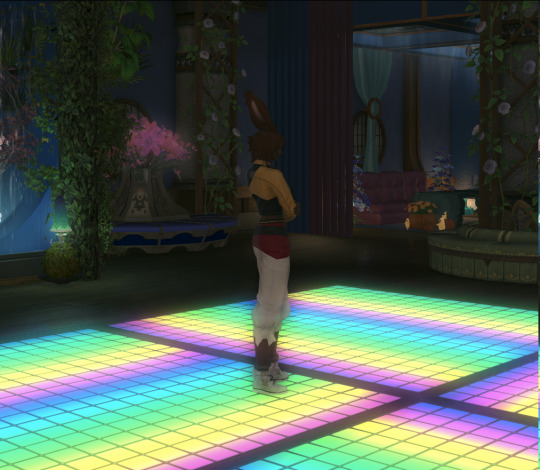
The Alive preset's colour grade improves matters a lot (this scene doesn't necessarily show the best of it, but removing the green tint and desaturation is a night and day difference throughout the game)...
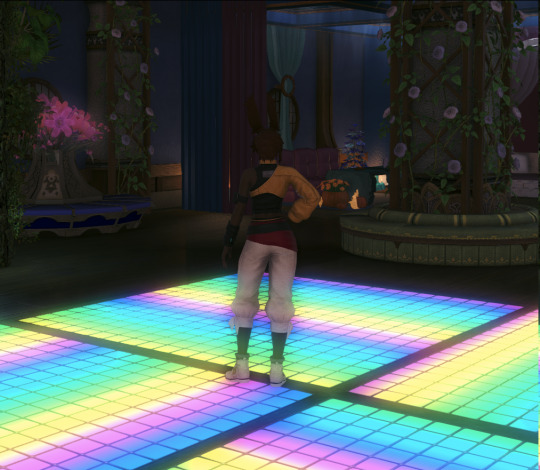
...but my character's legs should be affected by the bright floor. Enter SSRTGI. I can actually isolate the exact RTGI contribution:
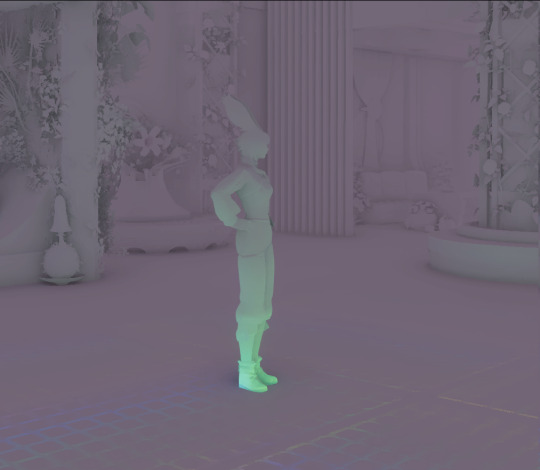
I've turned up the ray length a fair bit compared to the Alive preset's default, since it was a bit too subtle to be worth the performance hit otherwise.
You can see that the SSRTGI models both ambient occlusion and indirect light from bright surfaces. Essentially, each pixel traces a ray in a random direction until it hits a surface visible to the camera. Then, it samples the brightness of that pixel and calculates a light contribution and AO amount. I assume it does some kind of average over neighbouring pixels to smooth out the noise.
The effect is a little subtle, but it makes the scene look more integrated...
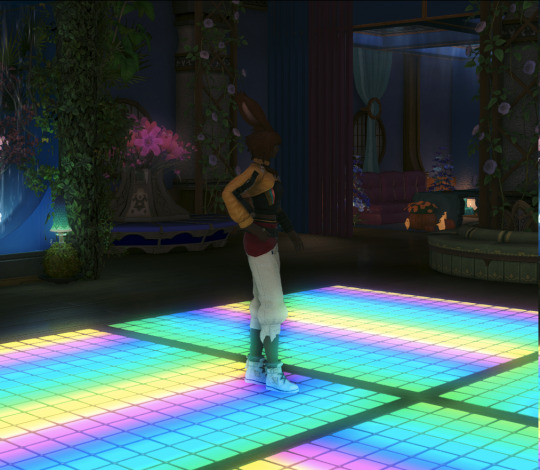
...at the cost of a hefty framerate hit (using a 4070Ti; unmodded FFXIV runs at an 1440p ultrawide on an easy 144fps (the monitor refresh rate), without RTGI I can get into the mid 90s, with RTGI it's pretty resolutely locked at 72), and heating my graphics card up to 70-80°C (well within tolerances but it's rare to see a game push it that hard).
The effect may be a little subtle in this scene, which has a lot of high frequency detail and darker materials. It really pops in the Fall Guys crossover, which is a very bright scene.
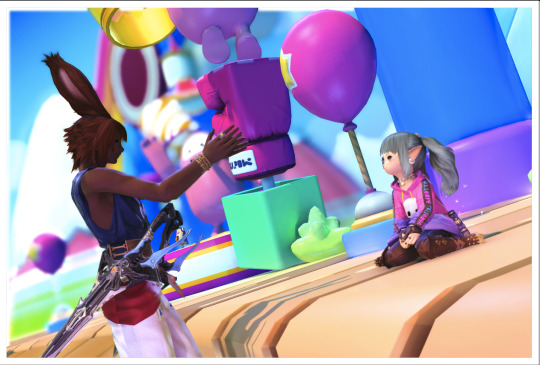
Note the bright green reflected light on the green cube as a particularly obvious RTGI effect (although the shadow it casts is kinda janky ngl). I should really get a screenshot of the exact RTGI contribution in this area, and create a suite of comparisons like the above.
The RTGI also stands out on bright days in Ul'dah, it does a lot for the Gold Saucer, and generally it makes certain environmental light sources a bit prettier. If you turn it up too much it starts to look a bit silly, since brightly lit floors turn into brilliant torches lighting up nearby walls. But there's a comfy middle ground where it's noticeable without being too extreme. I'm looking forward to seeing how it fares in the colourful areas of the expansions, but this character isn't out of ARR yet.
So, that's cool and all, but toying around with SSRTGI, you really start to feel its limits compared to true raytracing. For example, objects will cast shadows in the indirect lighting, but the specular light contributions are not properly affected by the base game's shadowmaps, so you see speculars in places that you shouldn't. A decent number of surfaces in FFXIV have planar reflections (using the usual technique of rendering the scene inverted through the mirror to a rendertexture), which is nice, but there's no middle ground between 'perfect mirror' and 'rough specular that still reflects the scene'. And of course the other usual limitations of SSRTGI, e.g. a brightly lit surface must be visible to the camera to contribute light.
No, this is nice and all, but the people want real raytracing. Which leads me to wonder is there a way to intercept all the draw calls issued by an application, extract the geometry from them, reformat it for raytracing and feed it into the raytracing hardware - basically replace the game's entire render pipeline with raytracing?
This is going to take some research. It very likely isn't possible, or performant if it was possible, because a lot of smart tech artists have already been working hard to push the limits of ENBSeries, Reshade, etc. (Acerola has a solid video on implementing various effects in Reshade.) But the imp of the perverse in me wants to figure out if it can be done. After all, RenderDoc is capable of intercepting and analysing all the draw calls issued by an application. The question is, how severe is the overhead of on-the-fly translating rasterisation calls into raytracing calls? Most likely absolutely hideous! That's not how you're supposed to use a graphics card!
Since the hardware I develop for very definitely does not support raytracing, I have relatively little idea how you actually write a shader with raytracing. But now I kind of want to find out. If I ever get anywhere beyond idle thoughts, I'll let you know what I find out.
17 notes
·
View notes
Note
I just can’t shake my mind off how broken an External Unstoppable user would be, I’m thinking like at least level 5 in Toaruverse OP.
What do you think plopping a hypothetical External Unstoppable into Academy City around the time Touma meets Misaka would result in?
The thing about Raildex is that, similar to Undead Unluck, there's a distinct difference between a power user's ability and its capacity
I'm sure you know, but for anyone who doesn't, the Esper powers in Raildex are divided as such: 0=no power/useless power/unobservable power, 1=observable power with minimal effect, 2=power that's impractical in everyday life, 3=power that's practical in everyday life, 4=power that's practical in military combat, 5=power that can stand alone against a military force, 6=immeasurable/absolute power
So let's say we transplanted Top from UU into Academy City and reversed Unstoppable's parameters - anything that Top throws will maintain its momentum regardless of interactions with outside forces
Again, much like UU, Raildex's power system is heavily governed by internal rules and logic - even Accelerator, the most power Level 5 esper, has to do all of the calculations in his head for how his power works (except for his automatic reflection ability, as that simply reverses the trajectory of whatever attempts to enter a set boundary). With that in mind, how well do you think Top would do in a world governed by mathematics?
Tozuka has never stated Top's IQ or anything, but he doesn't seem like he's supposed to be the smartest of the Union's forces. For argument's sake, we'll say that he's a perfectly average 15-year-old boy who does fine in school. To utilize his ability properly, he would need to factor in at minimum: the mass of the object he wants to throw; the velocity that he plans to throw it; the amount of resistance he would expect the object to need to overcome (wind resistance, physical objects, etc.)
I was a smart kid. I was great in school, got A's on everything, honor roll, yada yada, but if you asked me to look at a rock and tell you in exact detail how heavy it was, how hard I could throw it and how far it would go based on those factors, I'd be lost. I'd be lost now! And I'm just assuming the bare minimum factors that go into determining an object's velocity. If Top were taken as he is now and put into a world that requires he be a human calculator, I don't see any way he'd be able to do it reliably and would most likely end up being a Level 2 at best
Now, if he were raised in Academy City...thaaat would probably only help to the extent that he'd know what he's doing. Academy City raises espers based on a complex algorithm that predicts their potential ability against the potential cost of raising that ability. We're assuming that Top would manifest an ability at all, but if Academy City itself deems that Top will never make it past Level 2, they simply aren't going to put in the resources to nurture much anything beyond that. He may be able to teach himself the requisite formulas and how to use them in a practical setting, but at most that would get him from 2 to 3, and his capacity to become 4 or 5 is based solely on the interests of Academy City backers
Optimistically, if Top was deemed to have the potential to become a Level 5, he'd basically become a slightly less versatile Accelerator, but the factors that go into someone even managing to become a Level 5 in the first place are pretty vague beyond "prohibitively expensive"
But this is kind of a bad faith argument that doesn't really touch on what you're asking, does it? Let's circle back to the premise
What if we just put Top as is into Academy City - internal Unstoppable and all. What level would he be deemed by Academy City? His ability is perfectly observable, so he's at least level 1 - the need to break a limb is a huge drawback, so it's not exactly practical for everyday life, but if it can be compensated for by say, altering the parameters of one's Personal Reality (read: reevaluating the Rules of the ability), then it's definitely practical for combat, making Top a pretty easy Level 4. However, with the weakness of needing to break his body in order to deactivate it, he's certainly not strong enough to take out an entire army by himself - running face first into a wall of riot shields would definitely break something. But! If he gets enough velocity to be able to reliably create a sonic boom with a blast radius big enough to take out entire squadrons AND remove his inherent weakness, possibly even gaining the ability to travel through solid objects that would attempt to impede him...then we're looking at a Level 5 Top, I think
If he were to gain Level 5 and learn to reverse it so he can use it on other objects and himself...then he's just an Accelerator who would say no to killing the Misaka Sisters and never have conflict with Touma in the first place. He'd probably help fight Accelerator, honestly
...
OH SHIT, THEY'RE BOTH VOICED BY NOBUHIKO OKAMOTO
#undead unluck#fouryearsandananime#top bull sparx#to aru majutsu no index#a certain magical index#index#raildex#toaruverse
8 notes
·
View notes
Text
i want to keep tumblr because i like aesthetics
aesthetic aggregation is important because it allows for intimate relationships to develop outside of life-long domesticated-servile contracts
you transfer
love energy,
actually, when you share your aesthetic, and merge, like that
however
i don't think its possible to make organic relationships the same way it was a decade ago, no, entirely too sanitized
i highly doubt, since the algorithm that i'll ever oganically run into; actually its absurd to even finish that sentence
luckily, i became a sysadmin / programmer, in the interem period, and can actually build the tools this time around
i have an idea for an aesthetic aggregator portal place that combines dump.fm & tumblr with cellular automata, like a living pool you gaze into and everything's a ripple on a wave, man, that's like connected, woah
and i'm schemeing on it, i love lisp, when i go looking everything i want to do is available to me like channeling a spell... somebody already wrote scheme to wasm, that really shouldn't be too hard... still looking for alternate ways to chat :D hmu on xmpp it's exactly like AIM
i've tried node/npm, python, package managers... the best most satisfying one if you're going to go and install a big library, blob thing like that, is probably some flavor of emacs... for me, this is a personal preference, the fact that you 'can' do anything that rust/python/go/js can do in LISP... is enough for me, because, it is elegant, it is more pleasant to look at and easier to read, idk. loving my time with it recently and have been knocking it out of the park most days recently... the past 7 years i've been working on a top secret project, which will have a working alpha demo of the basic features by the end of next week :D
the best os rn is a freeBSD jail with guixSD GNU/linux-libre there's also hyperbola/BSD in the works you want to try to phase out the linux kernel because of all the google/microsoft shenanigans creeping in, you don't need unix/linux any more you can do all your daily driver stuff on an embedded, low power risc soc that costs under a hundo you need less overhead for embedded systems, there's microkernels like genome, and platforms like zephyr, its ok to move away idk one thing i learned its good to take a step back and look at the scope of what you're trying to achieve, try to strip away all the unneccessary parts... a mhz is 1,000,000 calculations a microsecond or whatever, when you sit down and write a piece of code how many calculations exactly do you need to do to do your business, honestly.
^these are the 3 am ramblings of a minimalist
i'm trying to find peers here on my site that's connected to the internet that's why i'm sending messages to it about my interests, pardon me, sir please send $1 to this address
3 notes
·
View notes